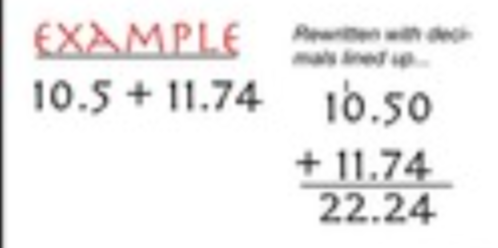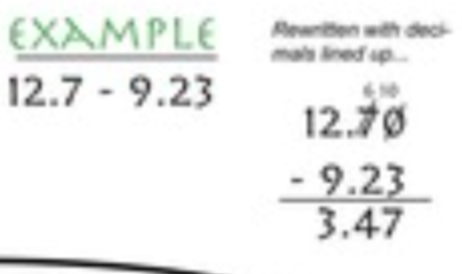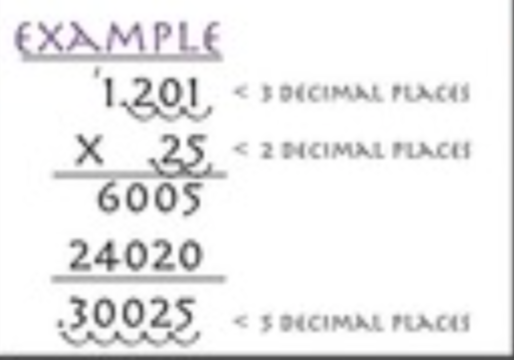bri aptitude test
1/23
There's no tags or description
Looks like no tags are added yet.
Name | Mastery | Learn | Test | Matching | Spaced |
|---|
No study sessions yet.
24 Terms
decimal addition rules
line up the decimals
fill in the empty spots with zero (not necessary, just helps with visualization)
add
bring down the decimal in answer

decimal subtraction rules
line up the decimals
fill in the empty spots with zero (not necessary, just helps with visualization)
subtract
bring down the decimal in answer

decimal multiplication rules
the number with the most digits goes on top
decimals do not have to line up
multiply like normal
count how many places in first number the decimal is moved over
count how many places in second number the decimal is moved over
this is how many places you move the decimal in your answer

decimal division rules
divisor can not have a decimal
move the divisor decimal so it is a whole number
move the same amount of places in dividend
place a decimal straight up where you write your answer, rewrite problem
divide like normal

fraction rules: adding fractions with common denominators
A/B + C/B = (A+C)/B
fraction rules: subtracting fractions with common denominators
A/B - C/B = (A-C)/B
fraction rules: adding fractions with different denominators
A/B + C/D = AD/BD + CB/DB = (AD+BC)/BD
fraction rules: subtracting fractions with different denominators
A/B - C/D = AD/BD - CB/DB = (AD - BC)/BD
fraction rules: multiplying fractions
A/B X C/D = AC/BD
fraction rules: dividing fractions
(A/B) / (C/D) = A/B X D/C = AD/BC
name some core laws of physics
Newton’s laws of motion
laws of mechanics
electromagnetism
laws of quantum mechanics
laws of solid state physics
laws of nuclear physics
what is the first law of Newton’s laws of motion
an object will not change its motion unless a force acts on it
what is the second law of Newton’s laws of motion
the force on an object is equal to its mass times its acceleration
what is the third law of Newton’s laws of motion
when two objects interact, they apply forces to each other of equal magnitude and opposite direction
how to convert fractions to percentages
multiply the top and bottom of the original fraction by a number that will make the answer’s denominator 100
20,19,17,14,10, __
5
how to evaluate the percent increase of something
original value = (new value) / (1+increase)
how to evaluate the percent change of something
100 X ((new value - original value) / original value)
% increase problem:
convert 12/25 to a percentage
48/100 = 48%